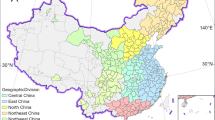Abstract
This paper inquires firstly into the influence of environmental potential population on population movements in China. We think that there are intimate relationships between the changes of the environmental potential population and the population movements: from southeast to northwest, from the coastland to the borderland in the early 30 years of the founding of the People’s Republic of China and the reversion of direction of population movements in recent ten years. Then we come to the conclusion that it has been inappropriate for a large-scale population movement of reclaiming and cultivating wasteland, because the actual population has universally surpassed the environmental potential population in most areas of China. But it is still appropriate and necessary for these movements, such as intelligence or science migration of population, limited population movement within the area of some provinces, population concentration on small towns and temporary fluidity of population.
Similar content being viewed by others
References
张善余. 人口研究, 1990, (1):1.
张 文涛, 等. 中国的环境与保护. 北京: 科学出版社, 1987, 365.
国家统计局. 人口与经济, 1988, (1):60.
田 方, 等. 中国人口迁移新探. 北京: 知识出版社, 1989, 139–144.
Author information
Authors and Affiliations
Rights and permissions
About this article
Cite this article
Yang, J., Jia, X. Population movements and the environmental potential population in China. Chinese Geographical Science 2, 322–328 (1992). https://doi.org/10.1007/BF02664563
Issue Date:
DOI: https://doi.org/10.1007/BF02664563




